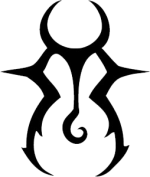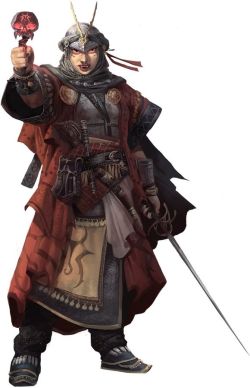« Zura » : différence entre les versions
Page créée avec « {{Badges|featured|art}} {{Deity | image = 150px|The demonic rune of Zura | name = Zura | titles = The Vampire... » |
Aucun résumé des modifications |
||
| Ligne 41 : | Ligne 41 : | ||
== Cult and worshipers == | == Cult and worshipers == | ||
[[File: | [[File:Vampire_Kyra.jpg|250px|right|thumb|Kyra, as a vampire, worshipping Zura and wielding the demon lord's [[unholy symbol]].]] | ||
Zura's worship is most common wherever blood-thirsty vampires and their thralls can be found. She is most commonly worshiped in the haunted counties of [[Ustalav]] and decadent cities of [[Cheliax]]. Azlanti ruins may attract Azlanti vampires who tend shrines to Zura there.<ref name="LoC29"/><ref name="Dimp63" /> | Zura's worship is most common wherever blood-thirsty vampires and their thralls can be found. She is most commonly worshiped in the haunted counties of [[Ustalav]] and decadent cities of [[Cheliax]]. Azlanti ruins may attract Azlanti vampires who tend shrines to Zura there.<ref name="LoC29"/><ref name="Dimp63" /> | ||
Version du 31 juillet 2017 à 11:36
| Zura | |
|---|---|

| |
| (Déité) | |
| Titres | The Vampire Queen, Demon Lord of Cannibalism and Vampires |
| Home | Nesh, the Abyss |
| Alignement | Chaotic evil |
| Portfolio | Blood Cannibalism Vampires |
| Adorateurs | cannibals, drow, Bekyar, vampires |
| Cleric Alignments | Modèle:Alignment grid |
| Domaines | Chaos, Death, Evil, Madness |
| Sous domaines | Blood, Demon, Murder, Undead |
| Arme de prédiléction | Rapier |
The demon lord Zura (pronounced ZOO-rah)[1] is also known as the Vampire Queen, and is worshiped by cannibals, drow, and of course, vampires.[2] Her unholy symbol is a blood-red, fanged skull, embossed with runes.[3]
History
Zura is believed to be the first vampire in all of creation. Supposedly she was an ancient Azlanti queen who possessed a lust for eternal life so great she eventually resorted to feeding on her own kind. Even thousands of years later, people still whisper the legends of her decadent, savage feasts and her baths of warm human blood. Some scholars even claim that her ascension heralded the beginning of the ancient Azlant empire's descent into decadence and eventual destruction at the beginning of the Age of Darkness.[4] Her sinfulness was so great that, on her death by botched suicide, her soul was sent to the Abyss, where she immediately arose as a succubus vampire. Before Earthfall she had ascended to demon lord status.[3][5]
Home
Zura now calls the mountainous Abyssal realm of Nesh her home.[2]
Relationships
Maybe Zura worshiped Urgathoa, the Pallid Princess, in life, but as a demon lord, their relationship is mercurial: sometimes they are firm allies and at other times they are at war.[2]
Appearance
She is said to appear as a voluptuous woman, with a dark gothic beauty that is almost impossible to resist. This beautiful form is merely a ruse she uses to seduce her victims; her true form is that of an emaciated woman with bat-like wings in place of arms, blood-red eyes and hair, large fangs, and taloned feet.[2][3][4]
Cult and worshipers

Zura's worship is most common wherever blood-thirsty vampires and their thralls can be found. She is most commonly worshiped in the haunted counties of Ustalav and decadent cities of Cheliax. Azlanti ruins may attract Azlanti vampires who tend shrines to Zura there.[2][3]
In the benighted depths of Sekamina, Zura is worshipped by the drow of House Rasivrein, who serve as the slave masters of the decadent drow cities.[6]
Zura is one of the Three Feasters, the deities worshiped by the Koboto tribe of the Sodden Lands.[7]
In the Mwangi Expanse, Zura is one of the main demons worshipped by the Bekyar tribes[8] and the ferocious halflings of the Kaava Lands.[9] One version of the legend of the mythical lost city of Zurakai is that it was founded by followers of Zura.[10] Some sabosan, failing to get spells from their erstwhile demon lord, Vyriavaxus, have turned to Zura.[11]
Cultists of Urgathoa mirror the relationship of their goddess with Zura cultists: sometimes they work together, sometimes cultists of one are sacrificed to the other. Maybe this conflict is due to the similar natures of the goddess' and the demon lord's portfolios.[2]
References
- ↑ Erik Mona et al. (2008). Campaign Setting, p. 247. Paizo Publishing, LLC. ISBN 978-1-60125-112-1
- ↑ 2,0 2,1 2,2 2,3 2,4 et 2,5 Modèle:Cite book/Lords of Chaos
- ↑ 3,0 3,1 3,2 et 3,3 Modèle:Cite book/Descent into Midnight
- ↑ 4,0 et 4,1 James Jacobs et al. (2011). The Inner Sea World Guide, p. 232. Paizo Publishing, LLC. ISBN 978-1-60125-269-2
- ↑ Modèle:Cite book/Lords of Chaos
- ↑ Modèle:Cite book/Endless Night
- ↑ James Jacobs et al. (2011). The Inner Sea World Guide, p. 175. Paizo Publishing, LLC. ISBN 978-1-60125-269-2
- ↑ Modèle:Cite book/Heart of the Jungle
- ↑ Modèle:Cite book/Heart of the Jungle
- ↑ Modèle:Cite book/Heart of the Jungle
- ↑ Modèle:Cite book/Vaults of Madness
- Pages avec des liens de fichiers brisés
- PathfinderWiki featured articles
- Zura
- Demon lords
- Demigods
- Chaotic evil deities
- Chaos domain deities
- Death domain deities
- Evil domain deities
- Madness domain deities
- CR 29 creatures
- Abyss/Inhabitants
- Nesh/Inhabitants
- Azlant
- Vampire
- Demon subdomain deities
- Murder subdomain deities
- Undead subdomain deities
- Blood subdomain deities